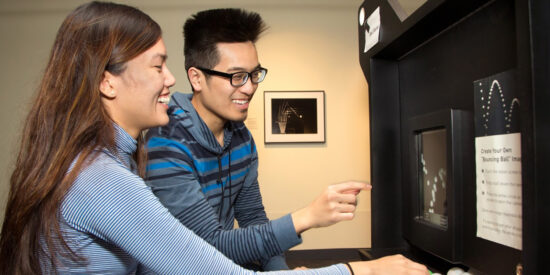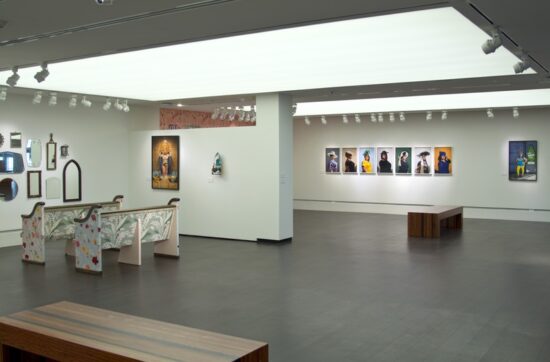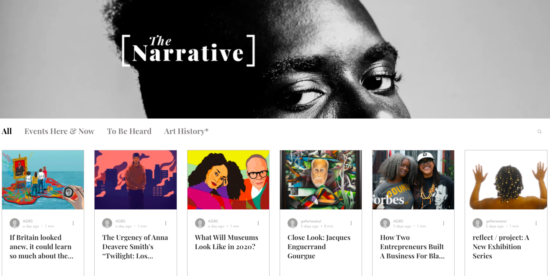This three-part series by contributing author Wided Khadraoui tackles how the coronavirus pandemic has presented an unparalleled opportunity for museum leaders to implement decisive and necessary change to the arts sector through the use of digital engagement, and considers how the digital sphere can better serve broader audiences every day, rather than just during a crisis. Click on the links here to read Part 1 and Part 2 of this series.
Understandably, much of the current conversation in the museum industry is centered around proper resources, including staffing, digital expertise, and new dissemination models. Digital and physical realms are different, and formats that work in one aren’t necessarily relevant or applicable to the other. “Some things we do in physical spaces do not translate well online. Storytelling is fundamentally changed when we can’t rely on physicality,”[i] said David Nuñez, author and Director of Technology and Digital Strategy at the MIT Museum. In the midst of global crisis, museums have been adapting as quickly as possible to digital opportunities to mitigate the financial blow. While museums have rushed to offer more and more online experiences as their brick-and-mortar spaces remain closed, strategically thinking about genuine audience engagement shouldn’t be deprioritized. “Our longer-term strategy includes how to present our content differently online. I’m always skeptical to replicate an onsite experience online, whether it’s AR or a virtual exhibition, but post-COVID19 there are potential opportunities on how to have social experiences in a new digitally-enhanced reality, simultaneously with others,” said Nuñez.[ii]

Photo from the MIT Museum website
It is crucial for institutions to make a distinction between digital and physical experiences, and to highlight that the digital forum isn’t a replacement for in-person engagement. This level of transparency is also needed when talking to visitors about the new virtual gatekeepers. It is each institution’s prerogative to create experiences for who they see their audience to be, but they need to be clear about that. “What do we stand to lose by being transparent and letting our audience know that they’re the point of everything we do?” asked Lise Ragbir, the Director of the Art Galleries at Black Studies at the University of Texas.[iii]
The AGBS (The Art Galleries at Black Studies at the University of Texas) launched a new online resource in June 2020 called The Narrative, an aggregator of local, national, and international resources. Their platform prioritizes unpacking timely social issues and furthering access to narratives behind the art, despite the current ban on access to the physical space. Through the arts, their newest initiative resolves to continue to highlight creative expression of Black people from across the Diaspora. “Everyone right now is talking about pivoting,” said Ragbir. “But pivot might not be the right word. This is more of an opportunity to press pause and look back at what we said we were going to do. Institutional mission statements rarely, if ever, declare ‘we are only going to show art in our physical space.’ Our missions are about educating, further conversations, triggering ideas, building access, creating communities. If we look at those tenets, there are other ways to accomplish what we’re trying to do [outside of physical sites].”[iv]

Installation view of Genevieve Gaignard’s In Passing in the Christian-Green Gallery at the University of Texas. Photograph courtesy of Mark Doroba.
The reactions to the new world’s challenges will be codified into policy, and as such this is an opportunity for genuine digital engagement to gather traction and rediscover its place in creating meaning and connections with audiences in profoundly different ways. Rather than simply curating online exhibitions that place a static image alongside a block of explanatory text, employing all that the virtual world has to offer requires creativity, and careful research. In creating new content and experiences, there is a wide array of factors to consider in addition to content, including chosen platforms, generational behaviors and expectations, and socioeconomic barriers, to name a few.
Museums have shown they have serious exposures to market vulnerabilities, and in a society where the habitual rules of engagement are no longer functional, deeper, more creative, and thoughtful solutions have to be explored. The new rules of experiencing museums invite critical questioning and changing the relationship between experience creation and community engagement. We must ask ourselves how the digital sphere might be made more accessible in the future, and more focused on complementing community demands. Using technology as a tool – one that must be continually honed – museums have an opportunity to examine, confront, and dismantle existing structures.
The pandemic crisis, coupled with increasing demands for institutions to stand up for social justice, is making a case for community led programming, dedicated inclusive missions, and new institutional frameworks. “It’s an opportunity for institutions to step back and really examine what we are trying to do,” said Ragbir. “This is about revolution. This is about reprioritizing. This is about understanding where money fits into the new prioritizing. It’s not a pivot, but an opportunity to really stand up for your mission.” [v]
[i] David Nuñez, video interview with author, April 6, 2020.
[ii] David Nuñez, video interview with author, April 6, 2020.
[iii] Lise Ragbir, video interview with author, April 22, 2020.
[iv] Lise Ragbir, video interview with author, April 22, 2020.
[v] Lise Ragbir, video interview with author, April 22, 2020.
Further Reading
AP NEWS. “Forbidden City, Parks in Chinese Capital Reopen to Public.” Associated Press, May 1, 2020. https://apnews.com/d65028a2a8b3247b9cd3dad20a8ad5be.
American Alliance of Museums. “American Alliance of Museums Urges US Congress to Include $4 Billion for Nonprofit Museums in COVID-19 Economic Relief Legislation.” American Alliance of Museums, March 19, 2020. https://www.aam-us.org/2020/03/19/american-alliance-of-museums-urges-us-congress-to-include-4-billion-for-nonprofit-museums-in-covid-19-economic-relief-legislation/.
Federal Communications Commision, 2019 BROADBAND DEPLOYMENT REPORT § (2019). https://docs.fcc.gov/public/attachments/FCC-19-44A1.pdf.
Indebted Cultural Workers, April 30, 2020. https://docs.google.com/document/d/1AYMV2VANegzpxdXGIlwjafwaG0ZcmUZcM26EZ1Tlj-I/edit.
McGill, Margaret Harding. “COVID-19 Resources Archives.” CultureConnect. AXIOS, March 12, 2020. https://cultureconnectme.com/category/covid-19-resources-portal/.
Merritt, Elizabeth. “TrendsWatch: The Future of Financial Sustainability The American Alliance of Museums’ Center for the Future of Museums,” n.d.
Pogrebin, Robin. “Met Museum Prepares for $100 Million Loss and Closure Till July.” The New York Times. The New York Times, March 18, 2020. https://www.nytimes.com/2020/03/18/arts/design/met-museum-coronavirus-closure.html.
Sharpe, Emily, and José da Silva. “Art’s Most Popular: Here Are 2018’s Most Visited Shows and Museums.” The Art Newspaper. The Art Newspaper, March 27, 2019. https://www.theartnewspaper.com/analysis/fashion-provides-winning-formula.
U.S. Census Bureau. Income and Poverty in the United States: 2018; Issued September 2019. https://www.census.gov/library/publications/2019/demo/p60-266.html.

